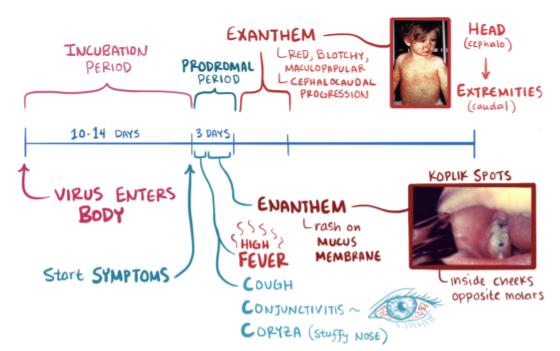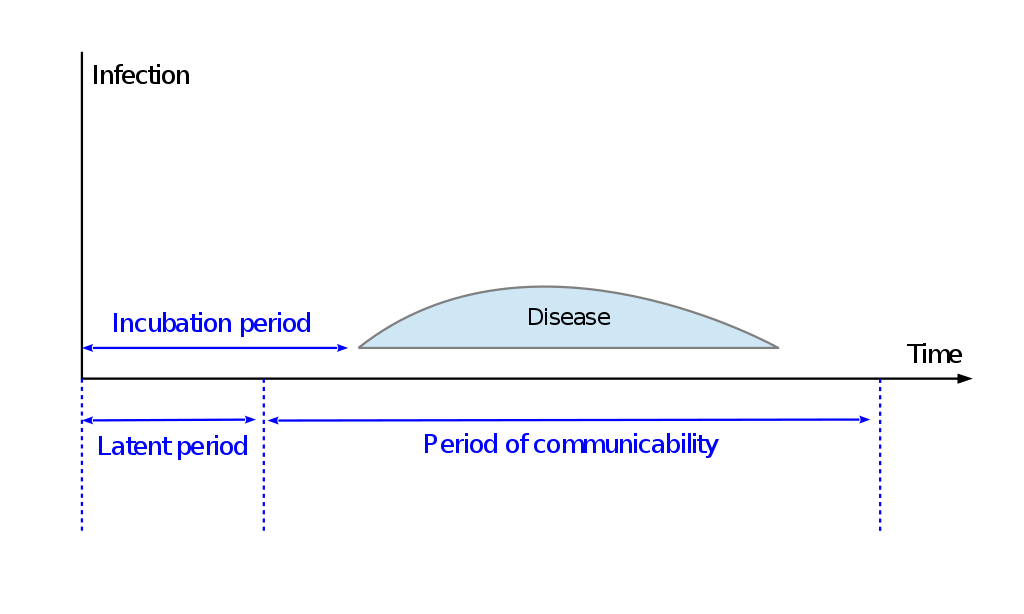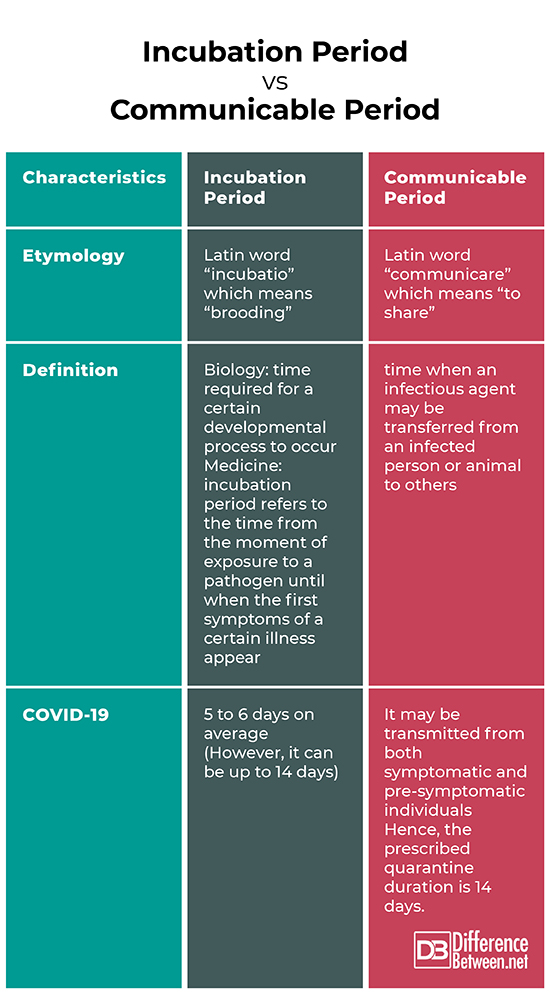Difference Between Incubation Period and Communicable Period
Incubation period and communicable period are both associated with epidemiology as they refer to phases concerning infectious diseases. These periods vary from person to person and significantly influence how infections are spread. Health and government professionals take note of these periods to promote the safety of the masses. Having accurate knowledge regarding these durations is essential in figuring out how long an exposed individual needs to stay in quarantine. Specifically, incubation period is the time from the moment of exposure to a pathogen until when the first symptoms of a certain illness appear; while communicable period refers to the time when an infectious agent may be transferred or spread.

What is Incubation Period?
“Incubation” came from the Latin word “incubatio” which means “brooding”. In biology, incubation period is the time required for a certain developmental process to occur. For instance, it is the length of time needed for chicken eggs to hatch. In medicine, incubation period refers to the time from the moment of exposure to a pathogen (biological agent which can cause diseases) until when the first symptoms of a certain illness appear. It can be just for a couple of hours or several months and even years (i.e. rabies). For instance, health care professionals identify the number of days between when patients are infected with a virus and when they manifest symptoms. During this phase, the disease is described as inapparent; however, pathological changes may be detected through laboratory tests. For example, individuals who have been exposed to patients who have been infected with Corona virus disease 2019 (COVID-19) are being tested for the disease even if they do not manifest symptoms.
According to the World Health Organization (WHO), the incubation period for COVID-19 is 5 to 6 days on average. However, it can be up to 14 days (2020). Hence, the prescribed quarantine duration is 14 days. The following table indicates the incubation period for some of the other common diseases (American Academy of Pediatrics, 2015):
| Disease | Number of Days |
| Chickenpox | 10 to 21 |
| Influenza | 1 to 4 |
| Measles | 7 t o 18 |
| Whooping cough (pertussis) | 5 to 21 |
| Rotavirus | 1 to 3 |
| Diarrhea and vomiting after exposure to Salmonella | 6 to 72 |
| Herpes (cold sores) | 2 to 14 |
| Rabies | 28 to 42 (4 to 6 weeks) but can last for years |
| Scabies | 28 to 42 (4 to 6 weeks) |

What is Communicable Period?
“Communicable” came from the Latin word “communicare” which means “to share”. Communicable period refers to the time when an infectious agent may be transferred from an infected person or animal to others; this is when the disease is said to be contagious. The spreading may be indirect (e.g. physical contact) or indirect (e.g. droplets in the air). For instance, COVID-19 may be transmitted from both symptomatic and pre-symptomatic individuals through respiratory droplets, direct physical contact, or by contact with contaminated surfaces. As for asymptomatic transmission, there has been no documented case to date. However, this does not rule out the probability that it may occur (WHO, 2020).
The following table reflects the contagious period of some of the common infections (Schmitt, 2014):
| Disease | Contagious Period |
| Chickenpox | 5 days before rash |
| Influenza (Seasonal) | Onset of symptoms until fever is gone over 24 hours |
| Measles | 4 days before until 5 days after rash appears |
| Whooping Cough | Onset of runny nose until 5 days on antibiotic |
| Vomiting , viral | Until vomiting stops |
| Mumps | 5 days before swelling until swelling gone |
| Cold Sores (herpes) | *Under age 6 years: they should stay home until the sores are dry (4 to 5 days) *Over age 6 years: does not need to stay home if beyond the touching, picking stage |
| Scabies | Onset of rash until one treatment |
| Tuberculosis | Until 2 weeks on drugs |
| Diarrhea, viral (Rotavirus) | *not toilet trained: should stay home until stools are formed *toilet trained: stay home until fever, blood, and mucus are gone; and when there is control over loose bowel movements |
Difference between Incubation Period and Communicable Period
Etymology
“Incubation” came from the Latin word “incubatio” which means “brooding”. In comparison, “communicable” came from the Latin word “communicare” which means “to share”.
Definition
In biology, incubation period is the time required for a certain developmental process to occur. In medicine, incubation period refers to the time from the moment of exposure to a pathogen until when the first symptoms of a certain illness appear. On the other hand, communicable period refers to the time when an infectious agent may be transferred from an infected person or animal to others; this is when the disease is said to be contagious.
COVID-19
According to the WHO (2020), the incubation period for COVID-19 is 5 to 6 days on average. However, it can be up to 14 days. Regarding its communicable period, it may be transmitted from both symptomatic and pre-symptomatic individuals. Hence, the prescribed quarantine duration is 14 days.
Incubation Period vs Communicable Period

Summary
- Incubation period and communicable period are both associated with epidemiology.
- Incubation period refers to the time from the moment of exposure to a pathogen until when the first symptoms of a certain illness appear while communicable period refers to the time when an infectious agent may be transferred.
- The incubation period for COVID-19 is 5 to 6 days on average (though it can be up to 14 days) and it may be transmitted from both symptomatic and pre-symptomatic individuals.
- Difference Between Hematoma and Melanoma - February 9, 2023
- Difference Between Bruising and Necrosis - February 8, 2023
- Difference Between Brain Hematoma and Brain Hemorrhage - February 8, 2023
Search DifferenceBetween.net :
Leave a Response
References :
[0]American Academy of Pediatrics. Red Book: 2015 Report of the Committee on Infectious Diseases. 2015
[1]Schmitt, Barton. My Child is Sick. American Academy of Pediatric Books. Relay Health, 2014. Print.
[2]World Health Organization. Coronavirus disease 2019, April 2020. https://www.who.int/docs/default-source/coronaviruse/situation-reports/20200402-sitrep-73-covid-19.pdf
[3]Image credit: https://commons.wikimedia.org/wiki/File:Concept_of_incubation_period.svg
[4]Image credit: https://commons.wikimedia.org/wiki/File:MeaslesOsmosisPic8.jpg
